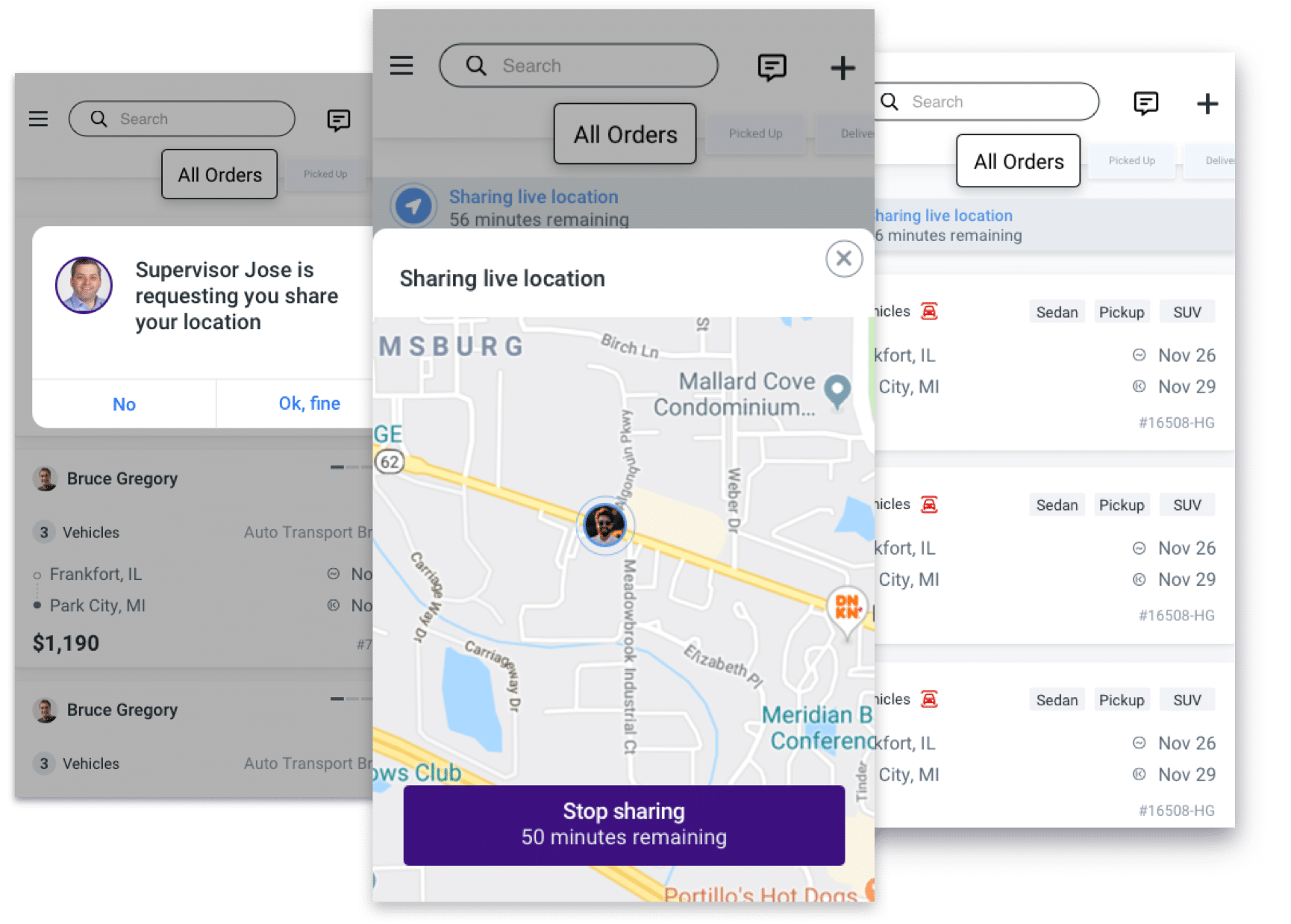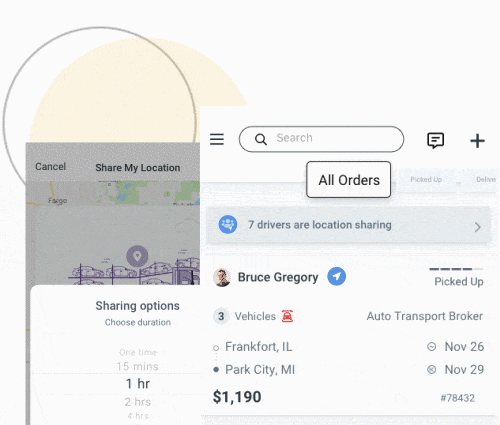Location Sharing
Ship.Cars Digital Bill of Lading app is a logistics tool for car haulers. It facilitates coordination between drivers, dispatchers, and brokers. Dispatchers need up to date driver location to be able to triage their tasks throughout the day.
The current version of Ship.Cars driver app only allows for location data on pick up and delivery. Dispatchers need this data on demand so they can relay that information to shippers and customers.


Understanding the Core Problem
Trust, Transparency, and Control
Competitive Analysis: I evaluated existing location sharing features in the car hauling market. I also evaluated location based features implemented tech industry leaders. Similar features existed within our competitive space. But, there were several key ingredients missing, not the least of which was lack of context on both ends of the data.
Research: The HERE location report showed that transparency, control, and in context requests correlated with user adoption. We were already aware that low trust often plagued relationships in car hauling. Knowing this, the PO and I prioritized those 3 things when for this feature.

It seems that the data economy only exists for data collectors and data processors. Data owners – consumers generating data by their behaviors – often feel neglected, and don’t see enough in return for exposing their location data.
“Only 20% feel they have full control over their location data, but around 70% would allow access if they could more easily change their settings, withdraw access and delete their history.”
– HERE Location Report
Goals
Drive High Trust Relationships
There were some internal disagreements over this feature. Key stakeholders felt that a ‘just deal with it’ solution was good enough. But, the product team felt that drivers should be in the driver’s seat when it came to their data. The HERE report as well as driver interviews backed up those findings, and with that in mind we looked to:
-
Facilitate a high trust relationship between all parties involved (brokers, dispatch, and drivers).
-
Give drivers control of when their location data is being accessed.
-
Give dispatchers the information they need to give accurate updates to every party involved in the delivery chain.
-
Deliver location data in context of existing and relevant user patterns.
“Only 20% feel they have full control over their location data, but around 70% would allow access if they could more easily change their settings, withdraw access and delete their history.”
– HERE Location Report
Scenario Mapping
How are dispatchers getting location data now?
We wanted to understand how dispatchers are currently getting the location of their drivers. After several user interviews we found that dispatchers were getting the location of their drivers in one of three ways:
-
Through a dedicated montoring application like Life 360.
-
Electronic logging devices.
-
Updates over the phone.
We wanted to support the former 2 but fasciltate this behavior in app while decreasing the necessity of phone calls. From there we defined use cases that would support existing user behavior.
“I’m big on communication… I’ll text or call my dispatchers to let them know when I will pick it up. I give an estimate for delivery and will periodically update in transit. Any delays, my dispatcher will know and relay that to the shipper…”
– Driver
“I’m big on communication… I’ll text or call my dispatchers to let them know when I will pick it up. I give an estimate for delivery and will periodically update in transit. Any delays, my dispatcher will know and relay that to the shipper…”
– Driver

Initial Design Review
Stakeholder Worshop
Stakeholders (CEO, POs, Devs, and Sales) reviewed initial lo to mid fi designs. The workshop evaluated the designs for potential risks, wins, requirement gaps, and areas of improvement. The group diverged to specific stations with each station having a specific purpose. The 4 stations were:
Blue Station: This station focused on ‘looking at the facts’. This included evaluating product requirements, share parameters, and whether the feature delivered on its core promise.
Pink Station: Looks for problems and risks.
Light Green Station: Look for what is good in the design.
Dark Green Station: Look for ways to improve.

The Feedback
After 10 minutes the group again converged and shared their notes. Each member of the group was encouraged to ask clarifying questions and challenge assumptions. There were some good content/copy suggestions that would provide more context to the flow.
Usability Testing
Time and resource constraints called for hallway testing. I conducted tests with five participants. I observed participants carrying out key tasks within this feature. I encouraged participants to talk through their thought process. Otherwise I remained a passive observer and timed each task completion time. The sessions helped to identify patterns that were friction points. The action of ‘dismissing’ a user that is currently sharing was not clear. Two expected more driver information upon selection of the driver on the live map view.

Iteration, Design, and Delivery
I reviewed findings from the workshop and usability sessions with the product owner. These adjustments informed refined designs. The design of the screens incorporated modern and accessible patterns. Illustrated/animated components added some delight. A pulse animation helped reinforce the ‘currently sharing’ status. I defined all key flows as well as all component behavior in anticipation of dev handoff.
Final Designs

Key Results
Stay Tuned…
A company re-org and resulting shift in priorities put this feature on the back burner. While management re-aligned new features were put on a temporary freeze. Chalk it up to the life of UX work in a startup space… Regardless, this project allowed me to flexibly incorporate research, rapid prototyping, and usability testing into my process. Key findings informed fast paced iteration. Stakeholders were engaged thoughtfully and with purpose. This project helped to establish a working process in light of limited resources.
Check out some other projects
Configurable Inspections
Ship.Cars Driver App
Industry leading feature that included a redesign to the Ship.Cars Driver app’s inspection flow and requirements. Carriers where asking for it and we gave it to them.
See Process »
Website Redesign
Ship.Cars Web Site
A new look for a traditional industry. This project entailed a complete overhaul of a car shipping SAAS platform website design.
See Process »

